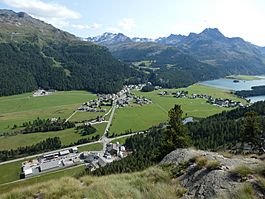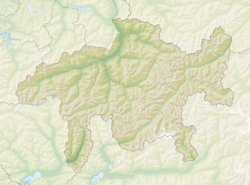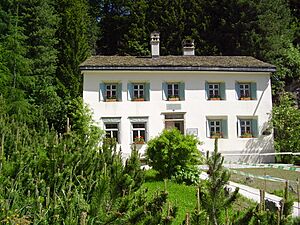Sils im Engadin/Segl facts for kids
Quick facts for kids
Sils im Engadin/Segl
|
||
|---|---|---|

Segl Maria (left) and Segl Baselgia (right)
|
||
|
||
| Country | Switzerland | |
| Canton | Graubünden | |
| District | Maloja | |
| Area | ||
| • Total | 63.58 km2 (24.55 sq mi) | |
| Elevation
(Church Segl Maria)
|
1,809 m (5,935 ft) | |
| Population
(Dec 2020 )
|
||
| • Total | 715 | |
| • Density | 11.246/km2 (29.126/sq mi) | |
| Postal code |
7514, 7515, 7517
|
|
| Localities | Segl Maria, Segl Baselgia, Seglias, Val Fex as well as Grevasalvas, Blaunca and Buaira | |
| Surrounded by | Bivio, Chiesa in Valmalenco (IT-SO), Lanzada (IT-SO), Samedan, Silvaplana, Stampa | |
Sils im Engadin/Segl is a charming village and municipality in the Maloja Region of Switzerland. It's located in the beautiful Upper Engadine valley in the Grisons canton.
This area is made up of two main villages: Segl Maria and Segl Baselgia. Segl Maria includes a smaller area called Seglias. Segl Baselgia means "Sils Church" in Romansh, which is a local language. The municipality also includes the lovely Val Fex (Fex Valley) and three traditional Alpine pastures: Grevasalvas, Blaunca, and Buaira. These pastures are found above a place called Plaun da Lej.
Contents
- Understanding the Name and Coat of Arms
- A Look Back at Sils History
- Exploring Sils Geography
- Population and People of Sils
- Languages Spoken in Sils
- Education and Learning in Sils
- Economy and Jobs in Sils
- Getting Around Sils
- Sils Climate and Weather
- Famous People Who Visited Sils
- Images for kids
- See also
Understanding the Name and Coat of Arms
The official name of the municipality, Sils im Engadin/Segl, uses both German and Romansh words. Segl is the Romansh name, while Sils im Engadin is the German name. "Engadin" means "Valley of the Inn" in Romansh. The Inn River flows through Sils Baselgia and eventually reaches the Danube River.
Sils im Engadin is different from another Swiss town called Sils im Domleschg. Long ago, Sils was split into three small areas: Segl Baselgia, Segl Maria, and Seglias.
The coat of arms for Sils im Engadin/Segl is very special. It has a blue top part with a golden sun, and a yellow bottom part with a blue trout. This design combines the old symbols of the villages. It shows that the area is sunny and high up, and that its lakes are full of fish, especially trout!
A Look Back at Sils History
Sils im Engadin/Segl was first mentioned in old writings around 800–850 AD. Back in Roman times, about 2,000 years ago, there might have been a special place of worship in Segl Baselgia. This is because four small altars, used for offerings, were found there. They were along an old Roman trade route that went over the Maloja Pass and the Julier Pass.
During the Middle Ages, Sils/Segl was an important stop for traders on this route. You can still see parts of a medieval castle on the Chastè peninsula in Lake Sils. Fishing was a big business back then. People would salt and smoke trout and send them to Italy.
In the 1800s, many people from Sils/Segl moved away. Some of them came back rich and helped the village become more successful. Later in the 1800s and into the 1900s, tourism became very important.
Many famous people have visited Sils. The philosopher Friedrich Nietzsche spent his summers here from 1881 to 1888. The house where he lived is now a museum called the Nietzsche-Haus. The Waldhaus hotel opened in 1908 and has hosted many artists, musicians, writers, and thinkers. In 1972, a cable car to Furtschellas opened, making Sils/Segl a popular place for winter sports too.
Exploring Sils Geography
Sils im Engadin/Segl is located in the Upper Engadine valley. It sits beautifully between two lakes, Lake Sils and Lake Silvaplana. The village is also at the base of two mountains, Piz Corvatsch and Piz da la Margna. To the south, you'll find the Val Fex, a peaceful valley.
The municipality covers an area of about 63.54 square kilometers (about 24.5 square miles). A good part of this land, about 25.9%, is used for farming. Forests cover about 11.1% of the area. The rest of the land includes buildings, roads, and areas that are not used for farming or forests.
The flat areas of Sils are covered in grass. The steep hillsides are covered with thick forests.
Population and People of Sils
Sils im Engadin/Segl has a population of about 761 people (as of December 2015). Many people who live here are from other countries. For example, in 2015, about 18.9% of the population was born in Portugal, 5.5% in Germany, and 8.3% in Italy.
In 2014, children and teenagers (up to 19 years old) made up about 17.3% of the population. Adults (20–64 years old) were 65.9%, and seniors (over 64 years old) were 16.8%. Most people in Sils are married or in a civil partnership.
The chart below shows how the population of Sils has changed over time:

Languages Spoken in Sils
Most people in Sils im Engadin/Segl speak German. About 59.4% spoke German in 2000. Italian is the second most common language (15.4%), and Romansh is third (12.0%).
For a long time, until the 1800s, almost everyone spoke a Romansh dialect called Putèr. But as more people came to trade, Romansh started to be spoken less. In 1880, about 68% spoke Romansh as their first language. By 1910, it was only 56%. German became the main language in the 1960s. However, in 2000, about 33% of the people still understood Romansh.
| Languages | Census 1980 | Census 1990 | Census 2000 | |||
|---|---|---|---|---|---|---|
| Number | Percent | Number | Percent | Number | Percent | |
| German | 210 | 48.39% | 291 | 58.43% | 446 | 59.39% |
| Romansh | 137 | 31.57% | 122 | 24.50% | 90 | 11.98% |
| Italian | 67 | 15.44% | 71 | 14.26% | 116 | 15.45% |
| Population | 434 | 100% | 498 | 100% | 751 | 100% |
Education and Learning in Sils
Many adults in Sils im Engadin/Segl have a good education. About 70.6% of people aged 25–64 have finished high school or gone on to higher education, like university.
Economy and Jobs in Sils
Sils im Engadin/Segl is known as a tourist community. This means that many jobs and businesses are related to tourism.
In 2014, there were 955 people working in the municipality. A small number of people (24) worked in farming businesses. More people (132) worked in manufacturing and construction. The largest number of jobs (799) were in the service industry, which includes hotels, restaurants, and shops.
Tourism is very important here. In 2015, hotels in Sils had over 196,000 overnight stays. About 37.6% of these visitors were from other countries.
Getting Around Sils
The Fex Valley is a special place because cars are not allowed, except for people who live there. This helps keep the valley peaceful and natural.
Near the village, you can find the Furtschellas cable car. This cable car takes people up the mountain to many ski runs in winter. In summer, it leads to hiking trails above the tree line, offering amazing views.
Sils Climate and Weather
Sils-Segl Maria has a cold subarctic climate. This means it has long, cold winters and short, cool summers.
| Climate data for Segl-Maria (1991–2020) | |||||||||||||
|---|---|---|---|---|---|---|---|---|---|---|---|---|---|
| Month | Jan | Feb | Mar | Apr | May | Jun | Jul | Aug | Sep | Oct | Nov | Dec | Year |
| Mean daily maximum °C (°F) | −1.3 (29.7) |
−0.2 (31.6) |
2.7 (36.9) |
5.7 (42.3) |
11.0 (51.8) |
15.3 (59.5) |
17.6 (63.7) |
17.0 (62.6) |
12.7 (54.9) |
8.8 (47.8) |
3.4 (38.1) |
−0.3 (31.5) |
7.7 (45.9) |
| Daily mean °C (°F) | −6.8 (19.8) |
−6.3 (20.7) |
−2.6 (27.3) |
1.2 (34.2) |
6.0 (42.8) |
9.8 (49.6) |
11.8 (53.2) |
11.7 (53.1) |
7.8 (46.0) |
3.8 (38.8) |
−1.2 (29.8) |
−4.9 (23.2) |
2.5 (36.5) |
| Mean daily minimum °C (°F) | −12.6 (9.3) |
−12.8 (9.0) |
−8.5 (16.7) |
−4.0 (24.8) |
0.7 (33.3) |
3.9 (39.0) |
5.8 (42.4) |
6.0 (42.8) |
2.8 (37.0) |
−0.9 (30.4) |
−5.3 (22.5) |
−9.6 (14.7) |
−2.9 (26.8) |
| Average precipitation mm (inches) | 48 (1.9) |
34 (1.3) |
47 (1.9) |
62 (2.4) |
90 (3.5) |
113 (4.4) |
109 (4.3) |
127 (5.0) |
97 (3.8) |
106 (4.2) |
104 (4.1) |
56 (2.2) |
994 (39.1) |
| Average snowfall cm (inches) | 60 (24) |
47 (19) |
54 (21) |
44 (17) |
8 (3.1) |
0 (0) |
0 (0) |
0 (0) |
3 (1.2) |
17 (6.7) |
55 (22) |
58 (23) |
346 (136) |
| Average precipitation days (≥ 1.0 mm) | 7.0 | 5.6 | 6.1 | 8.2 | 10.7 | 11.4 | 11.3 | 11.4 | 8.2 | 8.9 | 8.9 | 8.0 | 105.7 |
| Average snowy days (≥ 1.0 cm) | 7.0 | 6.2 | 5.9 | 5.3 | 1.2 | 0.1 | 0.0 | 0.0 | 0.5 | 2.0 | 6.2 | 7.4 | 41.8 |
| Average relative humidity (%) | 75 | 71 | 71 | 73 | 74 | 74 | 74 | 76 | 77 | 77 | 77 | 76 | 75 |
| Source: MeteoSwiss | |||||||||||||
Famous People Who Visited Sils
Many well-known people have enjoyed spending time in Sils. The famous philosopher Friedrich Nietzsche stayed here during the summers from 1881 to 1888. His summer home is now a small museum called the Nietzsche-Haus.
Anne Frank, who wrote a famous diary, also spent several vacations in Sils. The writer Hermann Hesse visited Sils too. Annemarie Schwarzenbach, a writer and photographer, lived in Sils starting in 1935 and sadly passed away there in 1942 after a bicycle accident.
Images for kids
See also
 In Spanish: Sils im Engadin/Segl para niños
In Spanish: Sils im Engadin/Segl para niños

















